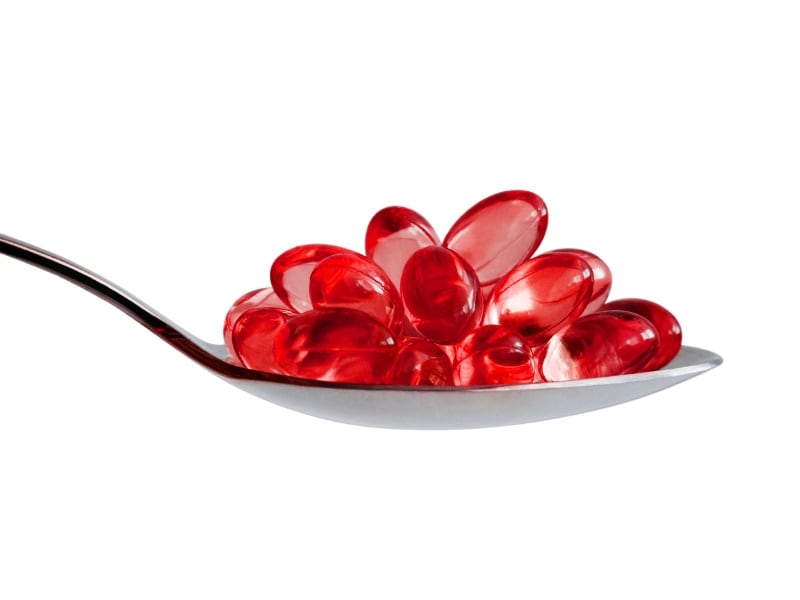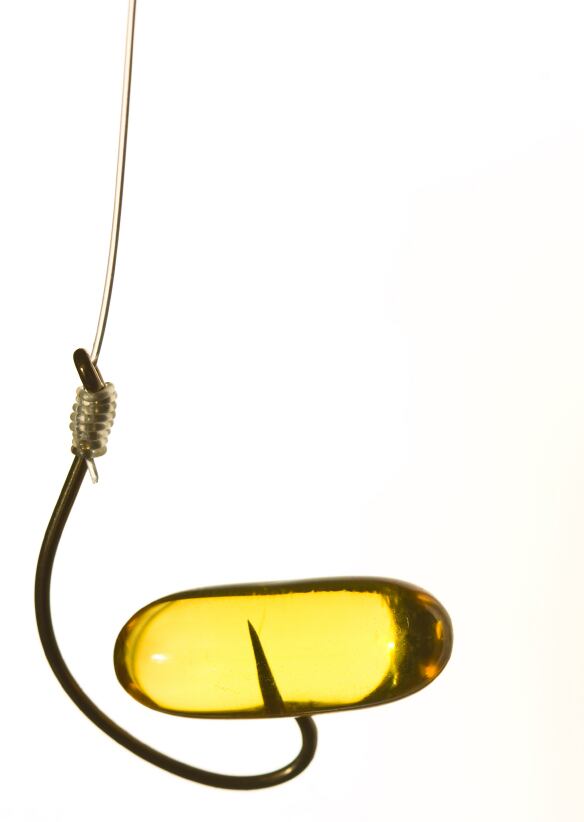The most vocal debate in the industry has been between the fish oil and krill oil suppliers, and studies are emerging that compare the bioavailability of these sources.
The krill oil supplements appear to be answering consumer demand for an alternative to fish oil supplements, and the smaller capsules and ‘improved consumer experience’ appears to be resonating with some consumers.
Indeed, krill supplier Aker Biomarine has said that krill sales were up 43% in the natural channel last year, with krill now accounting for 12% of total omega-3 supplement sales in the mass market.
Judgment
The question of a potential superiority between the forms – fish oil, which has omega-3 in triglyceride form, and krill oil, which delivers omega-3 in phospholipid form – is a relatively recent debate, and any claims of superiority may be premature.
Mary Dicklin, PhD, from Biofortis Clinical Research, told us: “At this time, a judgment of the superiority of one form of omega-3 to another relates primarily to differences in their bioavailability and EPA/DHA content.
“Products that do not require digestive enzymes in order to be absorbed, i.e., free fatty acid and phospholipid omega-3s, would be expected to have higher bioavailability than triglyceride and ethyl ester forms, and this would lead to more efficient incorporation of EPA and DHA into target organs.
“However, one needs to consider the quantity of EPA and DHA per capsule consumed and the cost per mg of EPA+DHA.”
Wael Massrieh, PhD, VP of scientific affairs for Neptune Technologies & Bioressources Inc., said: “It has been shown that phospholipids facilitate the passage of the fatty acids through the intestinal wall, increasing their bioavailability and ultimately improving the assimilation into different cells since they make up every cell membrane of the human body.”
The forms
Three clinical trials have included krill oil in a bioavailability comparison, with the majority of the science focusing on comparing EPA and DHA from natural triglyceride, re-esterified triglyceride, and ethyl ester sources.
A study by Schuchardt et al. (Lipids Health Dis. 2011, 10:145. doi:10.1186/1476-511X-10-145) demonstrated that there was a higher incorporation of EPA, DHA, and total omega-3 fatty acids into plasma phospholipids after ingestion of krill oil, compared with consuming re-esterified triglycerides derived from fish oil and ethyl ester forms, however these differences failed to reach statistical significance, said Dr Dicklin.
Dr Bill Harris, president of OmegaQuant Analytics and Professor of Medicine at the University of South Dakota, added that analysis of the krill oil used in the Schuchardt et al. paper revealed the presence of 20-22% free fatty acids.

“These are very well absorbed so any hint of better absorption in Schuchardt may be not from the phospholipids but from the free fatty acids in krill oil,” said Dr Harris. “At present, I'd say there is some evidence that krill oil may be a BIT better absorbed than fish oil omega-3 but the question is, is it worth the difference in price? We don't know yet.”
A comparison study between krill oil with menhaden oil led by Biofortis’ Kevin Maki, PhD, revealed that increases in plasma EPA and DHA were similar with ingestion of both oils (Nutr Res. 2009, Vol. 29, pp. 609-615). “However, when expressed per mg of EPA or DHA consumed there was a trend toward a greater increase in plasma EPA and DHA with krill oil,” said Dr Dicklin.
The third study, by Ulven et al. (Lipids. 2011, Vol. 46, pp. 37-46), found no statistically significant differences in changes in serum lipid levels, or in markers of inflammation and oxidative stress between the groups receiving krill oil (total EPA + DHA of 543 mg per day) or fish oil (total EPA + DHA of 864 mg per day).
A marathon and not a sprint
Harry Rice, PhD, VP of scientific and regulatory affairs for GOED, defines bioavailability as the fraction of unchanged substance that reaches the systemic circulation following administration by any route.

“Of course, the substance needs to get from point A to point B, but once it gets there, what really matters is that it does something,” he explained.
“The data we've seen thus far demonstrates that multiple forms (e.g. phospholipids, triglycerides, ethyl esters) of omega-3s get from point A to point B and are then incorporated into various tissues.
“Given that the benefits of the n-3 LCPUFAs are associated with chronic ingestion, does it matter who/what wins the first lap?
“If there is a need for the rapid appearance of omega-3s, then there may be a superiority story to report.
“For example, I could imagine that pre-surgical dosing prior to trauma surgery may be more effective using a phospholipid source compared to a triglyceride or ethyl ester source. Of course, such a hypothesis needs to be tested.”
Bioavailability vs bio-efficiency
While human data is limited to the three papers, there is plenty of animal data to support the claim that krill oil is superior for omega-3 bioavailability, said Kjetil Berge, R&D Director at Aker Biomarine Antarctic AS.
(For an in-depth review of omega-3 phospholipids, readers are encouraged to read: “Marine omega-3 phospholipids: Metabolism and Biological Actions” by L. Burri, N. Hoem, S. Banni, and K. Berge, Int. J. Mol. Sci., 2012, Vol. 13, pp. 15401-15419.)
Eric Anderson, Aker BioMarine Antarctic US, added: “We prefer to discuss bio-efficiency. Plasma EPA & DHA absorption is better than fish oil, but not dramatically so. The incorporation into cells, as measured by the Omega-3 Index, is significantly superior.”
Neptune’s Dr Massrieh said that the company has conducted a clinical study involving the different forms in relation to the Omega-3 Index. However, the company “has chosen to only share these data under strict confidentiality with its distributors it in order to maintain its competitive advantage against other krill oil suppliers.
“Within the clinical trial different sources of 100mg total EPA and DHA were compared to each other. (1) NKO (phospholipids) in comparison to other EPA/DHA formulations such as (2) ethyl esters, (3) TGs (fish oil) and (4) a fake krill oil (combination of phospholipids and TGs), were all administered over 112 consecutive days.
“The uptake characteristics of EPA and DHA were analyzed in plasma and erythrocytes. NKO demonstrated a greater increase of the Omega-3 Index and provided 2.5 times higher bioavailability of EPA & DHA compared to fish oil. (Reference: Clinical Study Report. NO. BTS 275/07. February 16, 2009.)
An alternate explanation?
Gunilla Traberg from Norwegian company Epax AS said: “It is interesting to point out that the phospholipid content of krill oil is just over 40%. The rest is 'fish oil' (in that) it is unconcentrated triglyceride oil. This means that a great part of the EPA and DHA in krill oil comes from ‘fish oil’ - not phospholipids.
“We also know that triglyceride molecules contain three fatty acids while the phospholipid molecule can only contain two fatty acids.
“Since the fish oil part is not concentrated, the amount of EPA and DHA in krill oil is relatively low compared to fish oil concentrates available on the market. In the draft from the Australian government on compositional guideline for Euphausia superba oil, the acceptance criteria are 70 – 190 mg/g of EPA and 30-160 mg/g of DHA.
“This means the total EPA and DHA is in the range of 100 to 350 mg/g while typical fish oil concentrates contain 500 mg/g to 700 mg/g or several times higher than what krill oil contains. We also know that krill oil is several times more expensive than concentrated fish oil today. This makes up, to some extent, for the difference in bioavailability.”
Price
As Traberg pointed out, the cost of krill is oil is always more per mg of EPA and DHA. Biofortis Clinical Research’s Dr Dicklin did some calculations for us, and found that the cost of Neptune Krill Oil, for example, works out at about 0.49 cents per mg EPA+DHA, while Mercola Krill Oil comes out at about 0.69 cents per mg EPA+DHA. (All prices are in US$)
Compare this with Carlson Laboratories Super Omega-3 Fish Oil where a milligram of EPA + DHA will cost 0.046 cents. Even going to the pharmaceutical grade fish oil, Lovaza, which delivers omega-3 in the ethyl ester form, will cost 0.21 cents per mg EPA+DHA.
“If one compares cost per mg of omega-3s, fish clearly is much less expensive,” said Aker’s Anderson. “So why would a retailer suggest krill? Well, krill are not fish. Krill is a small crustacean that provides phospholipid omega-3s with astaxanthin.
“Today, consumers are choosing krill as an alternative omega-3 with superior user experience for those that are sensitive to fish. Tomorrow, as consumer and retailer understanding of phospholipid benefits grows, I believe the phospholipid advantage will continue to grow the market.”
The choline issue
Omega-3s in the phospholipid form also offer an addition nutrient: Choline. “If the issue is EPA and DHA, there's no reason to believe that the different omega-3s forms will yield different results,” said GOED’s Dr Rice. “While I say that, keep in mind that phospholipid, not triglycerides or ethyl esters, oils contain choline, an essential nutrient for the structure of cell membranes.”
